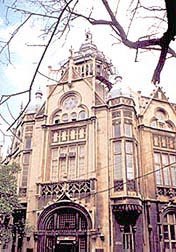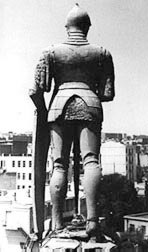|

Winter
1998 (6.4)
Architecture
of the Oil Baron Period
Wedding
Palace
Murtuza
Mukhtarov 6
The Mukhtarov Residence which
became the Wedding Palace during the Soviet period.
The statue which is affixed to the crown of the building but
from which the contractor slipped and fell to his death while
trying to secure.
One of the largest
mansions in the city, occupying nearly an entire city block,
belonged to Oil Baron Murtuza
Mukhtarov (1855-1920). Mukhtarov, known for his drilling
expertise, founded a large oil company with two divisions, employing
2,500 workers. The companies manufactured machinery for derricks
and drills for new wells.
Mukhtarov married Liza Taghinova, the daughter of an Ossetian
nobleman. Impassioned travelers, the couple traveled throughout
Europe. When his wife expressed delight in one of the French
Gothic palaces, Mukhtarov obtained the plans, and hired the famous
Polish architect I. K. Ploshko to modify it for Baku. The mansion
was built in 1911-1912.
A tragedy occurred during the construction of this building when
one of the contractors, Imran Gasimov, accidentally slipped and
fell to his death while trying to erect a statue on the crown
of the building high above the entrance. A week later, Gasimov's
wife, Rubaba Khanim, committed suicide, realizing that either
she would have to leave Baku or start wearing the chador (veil),
like other Moslem women. They had no children. The classical
statue, bearing witness to this great tragedy, can still be seen
today. In 1914, Liza Khanim organized the first Female Moslem
Philanthropic Society, which set up a boarding school for poor
and orphan girls inside the palace.
The lives of Mukhtarov
and Liza Khanim also ended in tragedy. Mukhtarov hated Stalin
and the Bolsheviks. Shortly before the Red Army entered Baku
in April 1920, he declared, "As long as I'm alive, no barbarian
will enter my house in soldier's boots." When Bolsheviks
charged into his Palace up the grand staircase, riding their
horses, he fired at them and then turned the gun on himself.
Soviets confiscated the property and Liza Khanim was forced to
live in the basement of the palace that had been built for her.
She eventually arranged a way to escape to Istanbul with a diplomat
only to be robbed by him. She died in the mid-1950s. Fortunately,
the enormous building with its elaborate highly decorative rooms
and high ceilings was not subdivided into apartments but rather
designated as a Wedding Palace where young couples come to register
their vows. Today, it still serves that purpose and ironically
is called the "Palace of Good Fortune." The Composers'
Union also maintains offices in one end of the building.
From Azerbaijan
International
(6.4) Winter 1998.
© Azerbaijan International 1998. All rights reserved.
Back to Index
AI 6.4 (Winter 1998)
AI Home
| Magazine
Choice | Topics
| Store
| Contact
us
|


